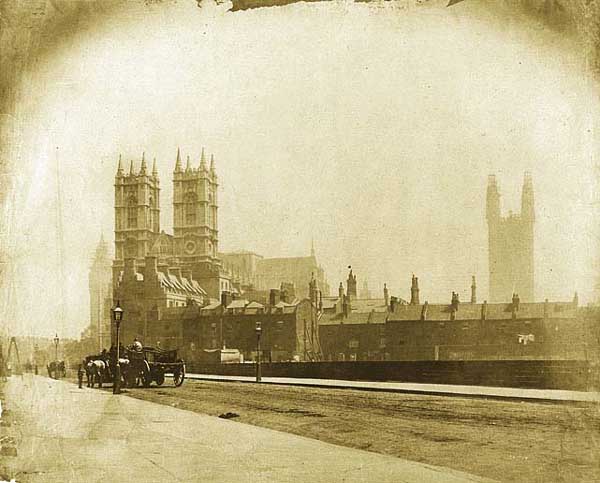This is over and above the fact that a major city like London is in a constant state of change and is for ever throwing up new visual relationships between the old and the new and redefining what might be termed a ‘sense of place’. It was a response to large-scale redevelopment which motivated many 19th century photographers of London’s urban landscape, both in terms of documenting the creation of the new (what we would now call ‘progress photography’) and in recording buildings and environments threatened with destruction (and felt to contribute significantly to London’s character, so generating a sense of loss).
The earliest of the capital’s urban landscape photographers was WHF Talbot, the inventor of the negative/positive process of photography, who in the 1840s recorded new buildings such as the attention-grabbing Royal Exchange in the City of London and Nelson’s Column in Trafalgar Square. As a scientist his mindset was firmly rooted in material progress and he seems to have had little interest in what was being destroyed to make way for these new marvels of civil engineering.
However, there were other photographers during the following decade, notably Charles Thurston Thompson (official photographer to the South Kensington Museum) and Roger Fenton (official photographer to the British Museum), whose work was informed by a sense of the past, but it was not until the 1860s that larger, more coherent bodies of work with a clear sense of purpose began to be made. In part this was due to the technical development of the medium itself (introduction of wet-collodion plates and faster lenses), and in part to the scale of the redevelopment projects which were taking place in London, especially transport-related ones such as the building of the underground railways and major new thoroughfares.
Not every project was systematically photographed but two that were are of particular significance. The building of the Metropolitan District Railway from Paddington to Blackfriars via Kensington, Westminster and the simultaneously-built Victoria Embankment was a huge undertaking for its time (1865-1870). Its progress was systematically documented by Henry Flather, an otherwise undistinguished portrait photographer, who produced a remarkable body of images (over 60) which record not only the construction work itself (including the men without whose hard labour the whole enterprise would not have been possible) but also the wider landscape through which the line was being cut.
Although an underground railway, the method of construction was ‘cut and cover’ so surface excavation was required throughout its length. A particular feature of Flather’s approach was the way he pictured the construction work in relation to familiar landmarks such as Westminster Abbey and Blackfriars Bridge. Also of interest is the fact that Flather’s portable darkroom (needed to sensitise the wet-collodion plates just before exposure) is clearly visible in a couple of the pictures.
page 1 Talbot, Fenton and Flather
page 2 Dixon and Bools
page 3 Strudwick
WHF Talbot: Nelson’s Column under construction, Trafalgar Square, 1843

Roger Fenton: Westminster Abbey looking towards the Houses of Parliament under
construction, c.1857
Henry Flather: Paddington Underground Station under construction, c.1866.
(Note Flather’s portable darkroom standing on the trackbed)
Henry Flather: site clearance prior to excavation work, near Westminster Abbey,
c.1866